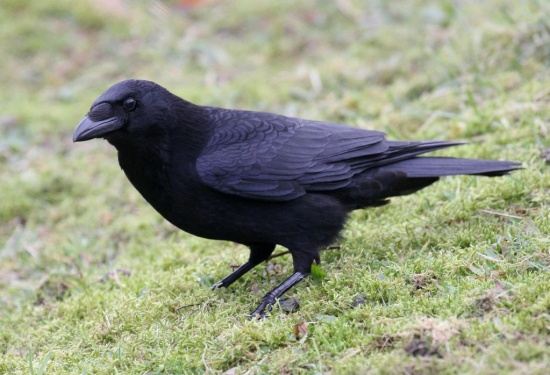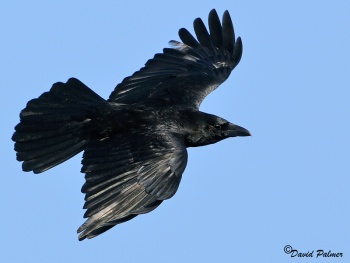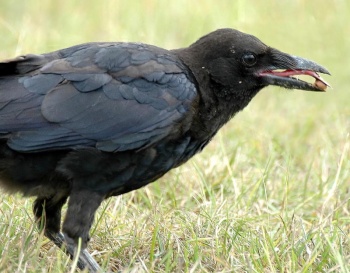m |
Nutcracker (talk | contribs) m (format) |
||
| (6 intermediate revisions by 2 users not shown) | |||
| Line 1: | Line 1: | ||
| − | [[Image: | + | [[Image:Corvus corone by G6 UXU.jpg|thumb|550px|right|Adult<br />Photo by {{user|G6+UXU|G6 UXU}}<br />Entwistle Reservoir, Lancashire, UK]] |
| − | '''Alternative names: Common Crow; Eurasian Crow; Oriental Crow (''orientalis | + | '''Alternative names: Common Crow; Eurasian Crow; Oriental Crow (''C. c. orientalis'')''' |
;[[:Category:Corvus|Corvus]] corone | ;[[:Category:Corvus|Corvus]] corone | ||
| − | |||
==Identification== | ==Identification== | ||
48-54cm. A compact crow: | 48-54cm. A compact crow: | ||
| − | * | + | * All black plumage with a green or purple sheen |
| − | |||
* Dark brown iris | * Dark brown iris | ||
* Black, stout bill | * Black, stout bill | ||
* Legs dark grey to black | * Legs dark grey to black | ||
| − | + | Sexes similar, juveniles with duller plumage and pink gape when bill open. Hybrids between Carrion Crow and [[Hooded Crow]] occur regularly in a narrow band where their ranges meet. | |
| − | Sexes similar, juveniles with duller plumage. Hybrids between | ||
====Similar species==== | ====Similar species==== | ||
| − | + | May be confused with young [[Rook]]. The shape of head and the flight are quite different. | |
==Distribution== | ==Distribution== | ||
| − | Most of western [[Europe]] | + | [[Image:PAL8074CARRIONCROW.jpg|thumb|350px|right|Carrion Crow in flight<br />Photo by {{user|I4ani|I4ani}}<br />Dartmoor, Devon, [[UK]], 2010]] |
| + | Most of western [[Europe]] and a disjunct population (perhaps a separate species) in central and eastern parts of northern [[Asia]].<br /> | ||
Common or abundant in most of its range despite persecution by gamekeepers and farmers. | Common or abundant in most of its range despite persecution by gamekeepers and farmers. | ||
==Taxonomy== | ==Taxonomy== | ||
| − | ====Subspecies<sup>[[#References|1]]</sup> | + | Was formerly considered conspecific with [[Hooded Crow]], which occupies central Eurasia inbetween the two subspecies of Carrion Crow. Precise relationship between the three taxa not yet settled, and possible that either Hooded may be re-lumped, or ''C. c. orientalis'' split as a third full species. |
| − | *''C. c. corone'' - Western [[Europe]] | + | ====Subspecies==== |
| − | *''C. c. orientalis'' - [[Iran]] to northern [[China]], [[Korea]] and [[Japan]] | + | Two subspecies accepted<sup>[[#References|1]]</sup>: |
| − | + | *''C. c. corone'' - Western [[Europe]] (except Ireland and northwest Scotland) | |
| − | + | *''C. c. orientalis'' - Northeastern [[Iran]] to northern [[China]], [[Korea]] and [[Japan]] | |
| − | + | ||
| − | |||
| − | |||
| − | |||
| − | |||
| − | |||
==Habitat== | ==Habitat== | ||
| − | Found almost anywhere from coast to moorland, even city centres. <sup>[[#References|3]]</sup> | + | Found almost anywhere from coast to moorland, even city centres and intensively farmed land.<sup>[[#References|3]]</sup> |
==Behaviour== | ==Behaviour== | ||
| − | Ingenious adaption to | + | [[Image:Carrion_Crow.jpg|thumb|350px|right|Juvenile<br />Photo by {{user|RichUK|RichUK}}]] |
| − | + | Ingenious adaption to urban environments and intelligent. Can be observed sitting atop of trafficlights and dropping hard-shelled nuts onto the streets below so to make use of the crushing effects of traffic; and will wait to retrieve the contents at a 'red' signal. | |
====Diet==== | ====Diet==== | ||
The diet includes carrion, insects, worms, seeds, fruit and scraps. | The diet includes carrion, insects, worms, seeds, fruit and scraps. | ||
====Breeding==== | ====Breeding==== | ||
| − | Breeding season generally in northern spring. A pair stays often together over several years and throughout the year. Usually a solitary nester. The large nest is built by both sexes and is made out of sticks. It's usually placed high in a tall tree. Nests on buildings, electricity pylons or cliffs are also known. Lays | + | Breeding season generally in northern spring. A pair stays often together over several years and throughout the year. Usually a solitary nester. The large nest is built by both sexes and is made out of sticks. It's usually placed high in a tall tree. Nests on buildings, electricity pylons or cliffs are also known. Lays four eggs. The chicks leave the nest after 32 days. In some parts of the range [[Great Spotted Cuckoo]] may parasitise the nest. |
====Vocalisation==== | ====Vocalisation==== | ||
<flashmp3>Corvus corone (song).mp3</flashmp3><br /> | <flashmp3>Corvus corone (song).mp3</flashmp3><br /> | ||
| Line 43: | Line 36: | ||
==References== | ==References== | ||
# Clements, James F. 2007. ''The Clements Checklist of Birds of the World''. 6th ed., with updates to October 2007. Ithaca: Cornell University Press. ISBN 9780801445019 | # Clements, James F. 2007. ''The Clements Checklist of Birds of the World''. 6th ed., with updates to October 2007. Ithaca: Cornell University Press. ISBN 9780801445019 | ||
| − | # Parkin, D.T., M. | + | # Parkin, D. T., Collison, M., Helbig, A., Knox, A. G., & Sangster, G. (2003). The taxonomic status of Carrion and Hooded Crows. ''British Birds'' 96 (6): 274–290. |
#RSPB | #RSPB | ||
#{{Ref-HBWVol14}} | #{{Ref-HBWVol14}} | ||
{{ref}} | {{ref}} | ||
==External Links== | ==External Links== | ||
| − | {{GSearch|Corvus+corone}} | + | {{GSearch|Corvus+corone}} |
<br /> | <br /> | ||
{{Video|Carrion_Crow}} | {{Video|Carrion_Crow}} | ||
| + | Threads about taxonomy of Hooded and Carrion Crow:<br /> | ||
| + | [http://www.birdforum.net/showthread.php?t=102015] and [http://birdforum.net/showthread.php?t=119618] | ||
[[Category:Birds]][[Category:Corvus]][[Category:Bird Songs]][[Category:Videos]] | [[Category:Birds]][[Category:Corvus]][[Category:Bird Songs]][[Category:Videos]] | ||
Revision as of 00:23, 14 December 2014
Alternative names: Common Crow; Eurasian Crow; Oriental Crow (C. c. orientalis)
- Corvus corone
Identification
48-54cm. A compact crow:
- All black plumage with a green or purple sheen
- Dark brown iris
- Black, stout bill
- Legs dark grey to black
Sexes similar, juveniles with duller plumage and pink gape when bill open. Hybrids between Carrion Crow and Hooded Crow occur regularly in a narrow band where their ranges meet.
Similar species
May be confused with young Rook. The shape of head and the flight are quite different.
Distribution
Most of western Europe and a disjunct population (perhaps a separate species) in central and eastern parts of northern Asia.
Common or abundant in most of its range despite persecution by gamekeepers and farmers.
Taxonomy
Was formerly considered conspecific with Hooded Crow, which occupies central Eurasia inbetween the two subspecies of Carrion Crow. Precise relationship between the three taxa not yet settled, and possible that either Hooded may be re-lumped, or C. c. orientalis split as a third full species.
Subspecies
Two subspecies accepted1:
- C. c. corone - Western Europe (except Ireland and northwest Scotland)
- C. c. orientalis - Northeastern Iran to northern China, Korea and Japan
Habitat
Found almost anywhere from coast to moorland, even city centres and intensively farmed land.3
Behaviour
Ingenious adaption to urban environments and intelligent. Can be observed sitting atop of trafficlights and dropping hard-shelled nuts onto the streets below so to make use of the crushing effects of traffic; and will wait to retrieve the contents at a 'red' signal.
Diet
The diet includes carrion, insects, worms, seeds, fruit and scraps.
Breeding
Breeding season generally in northern spring. A pair stays often together over several years and throughout the year. Usually a solitary nester. The large nest is built by both sexes and is made out of sticks. It's usually placed high in a tall tree. Nests on buildings, electricity pylons or cliffs are also known. Lays four eggs. The chicks leave the nest after 32 days. In some parts of the range Great Spotted Cuckoo may parasitise the nest.
Vocalisation
<flashmp3>Corvus corone (song).mp3</flashmp3>
Listen in an external program
References
- Clements, James F. 2007. The Clements Checklist of Birds of the World. 6th ed., with updates to October 2007. Ithaca: Cornell University Press. ISBN 9780801445019
- Parkin, D. T., Collison, M., Helbig, A., Knox, A. G., & Sangster, G. (2003). The taxonomic status of Carrion and Hooded Crows. British Birds 96 (6): 274–290.
- RSPB
- Del Hoyo, J, A Elliott, and D Christie, eds. 2009. Handbook of the Birds of the World. Volume 14: Bush-shrikes to Old World Sparrows. Barcelona: Lynx Edicions. ISBN 978-8496553507
Recommended Citation
- BirdForum Opus contributors. (2024) Carrion Crow. In: BirdForum, the forum for wild birds and birding. Retrieved 19 April 2024 from https://www.birdforum.net/opus/Carrion_Crow
External Links
Threads about taxonomy of Hooded and Carrion Crow:
[1] and [2]






